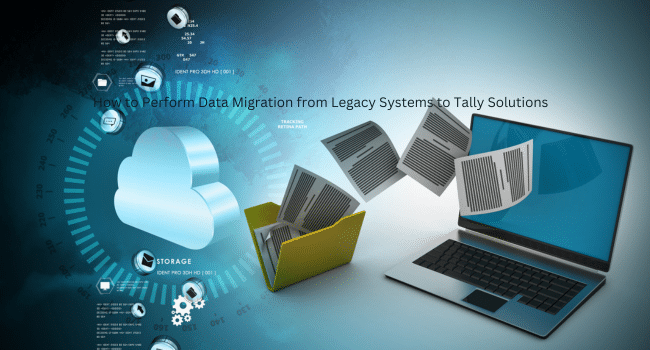Table of Contents
Transferring data to Tally Solutions is a multi-faceted undertaking that needs prior ‘thinking’, a methodical approach to the appropriate activities, and the imposition of the needed checks and measures to avoid adverse effects on business operations.
In this detailed guide, we’ll go through the stages involved and see how to perform data migration from legacy systems to Tally software in a simple and easy way.
Table of contents:
- Understanding Data Migration Requirements
- Data Preparation and Implementation
- Quality Assurance, Training, and Post-Migration Activities
- Best Practices for Long-term Success
- Risk Management and Security Considerations
Understanding Data Migration Requirements
Before diving into how to perform data migration from legacy systems to Tally accounting software, let us first see in detail about the requirements for data migration.
Assessing Current Systems
Before initiating the migration process to Tally ERP software, organizations must thoroughly evaluate their existing systems. This includes analyzing current data structures, identifying critical business information, and understanding the complexities of legacy systems. A comprehensive assessment helps determine the scope of migration and potential challenges that may arise during the transition.
Evaluating Business Needs
Understanding your organization’s specific requirements is crucial for successful migration. Consider factors such as transaction volume, reporting needs, compliance requirements, and industry-specific processes. This evaluation helps determine whether Tally Prime or Tally ERP 9 better suits your business needs and what level of Tally Customization might be necessary.

Data Preparation and Implementation
Data preparation is an important step in the process of data migration. Standardize data formats across all systems to ensure compatibility with Tally accounting software. This process involves normalizing date formats, currency representations, and account codes. Implement rigorous validation procedures to ensure data accuracy, checking for mathematical accuracy in financial records, consistency in customer and vendor information, accuracy of inventory records, completeness of transaction histories, and integrity of master data.
During the implementation process, configure Tally Software according to your business requirements. This involves setting up company information and profiles, chart of accounts, tax configurations, user access controls, and reporting parameters. Create detailed mapping documents that outline how data fields from legacy systems correspond to Tally Solutions. Proper mapping ensures all information transfers correctly and maintains relationships between different data elements.
Conduct a pilot migration using a subset of data to identify potential issues and refine the migration process. This test run helps validate the migration approach and ensures all systems work as expected. Once satisfied with the pilot, execute the full data migration according to the established plan. Monitor the process closely and maintain detailed logs of all activities. Having a rollback plan ready ensures business continuity if unexpected issues arise.
Quality Assurance, Training, and Post-Migration Activities
After migration, perform thorough verification of migrated data to ensure accuracy and completeness. Compare totals, balances, and key metrics between legacy systems and Tally accounting software. Address any discrepancies immediately. Conduct functional testing to verify that all business processes work correctly in the new system, including financial reporting, transaction processing, system integration, and user access controls.
Develop comprehensive training programs for different user groups, covering basic navigation, daily operations, and advanced features of Tally Solutions. Include hands-on practice sessions and provide detailed documentation for reference. Establish a support system for users during and after migration, including help desk setup, troubleshooting procedures, documentation resources, and feedback mechanisms.
Best Practices for Long-term Success
Post-migration activities that are what you should do after finishing migration of data from your old computer to Tally software is very essential for the long-term success of your business. The main thing you should do is maintain detailed documentation of:
- Migration procedures
- System configurations
- Customizations
- Troubleshooting guides
- User manuals
Regularly assess system usage and identify opportunities for improvement. Stay updated with new features and capabilities of Tally Solutions to maximize your investment. Fine-tune the system based on user feedback and performance monitoring. Implement necessary Tally Customization to optimize workflows and improve efficiency.
Risk Management and Security Considerations
Transferring important business data is not an easy job. It needs to be carefully done and not just with preparation for migration and or the transfer part, you also need to be cautious in managing other factors like risk and security considerations. Here are some things you need to keep in mind while migrating data to Tally Solutions.
Data Security Protocols
Implementing strong security measures during migration to Tally Solutions is necessary for protecting sensitive business information. Establish encryption protocols for data transfer and storage. Ensure that all security features within Tally accounting software are properly configured, including user authentication systems and access controls. Regular security audits during the migration process help identify and address potential vulnerabilities.
Risk Assessment and Mitigation
Conduct thorough risk assessments before and during the migration process. Identify potential threats to data integrity, system availability, and business continuity. Develop mitigation strategies for each identified risk, including:
- Network security breaches
- Data corruption during the transfer
- System downtime impacts
- Integration failures
- User access issues
Business Continuity Planning
Maintain business operations throughout the migration to Tally Software. Develop contingency plans for critical business processes. Keep legacy systems operational until the new system is fully validated. Create detailed rollback procedures in case of significant issues during migration.
Compliance Requirements
Ensure the migration process adheres to relevant regulatory requirements and industry standards. Document all compliance measures taken during the migration. This is particularly important for financial data and sensitive business information. Regular compliance audits during migration help maintain adherence to required standards.
Seeking a Tally partner solves all these confusions and gives you a one stop solution as they know how to work with Tally and safely handle the data migration processes. Not only that, they are also aware of the local laws and compliance so you need not worry about laws and regulations.
Disaster Recovery Procedures
Implement comprehensive backup and recovery procedures. Maintain multiple backup copies of data at different stages of migration. Establish clear protocols for data recovery in case of unexpected issues. Regular testing of recovery procedures ensures their effectiveness when needed.
The Bottom Line
Transforming the Tally Solutions with data migration is more than just a data transfer operation. It is more of restructuring, process enhancement, improving productivity, and equipping the enterprises with the right tools for analysis.
With the help of these detailed recommendations and methods, organizations will be able to facilitate the changeover to Tally Prime or Tally ERP 9 with overall risk minimization and improve their business results in the future.
